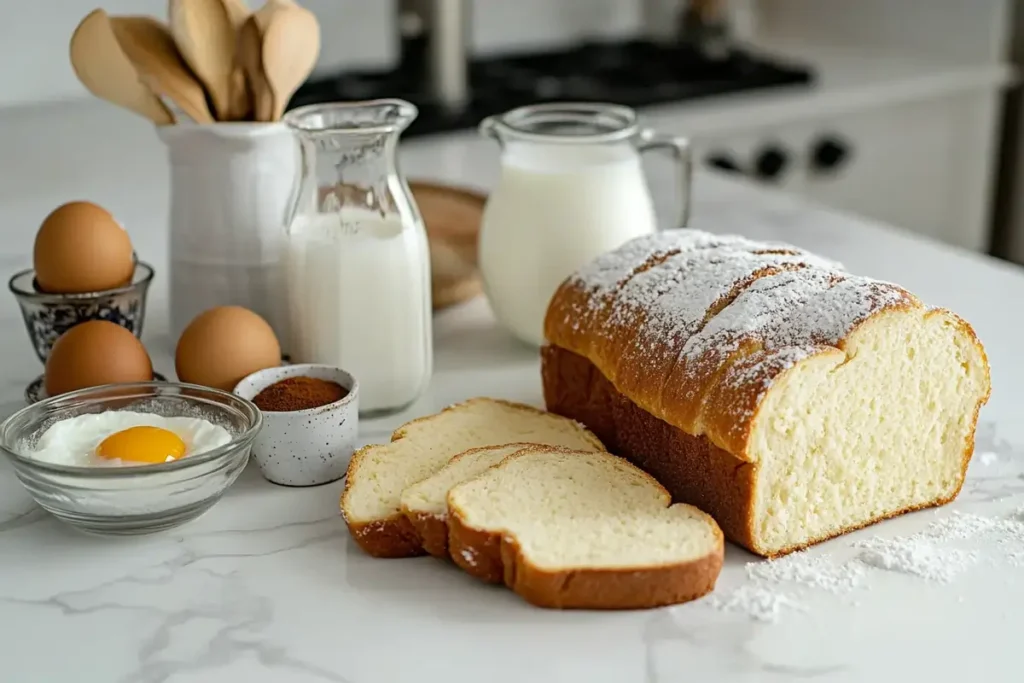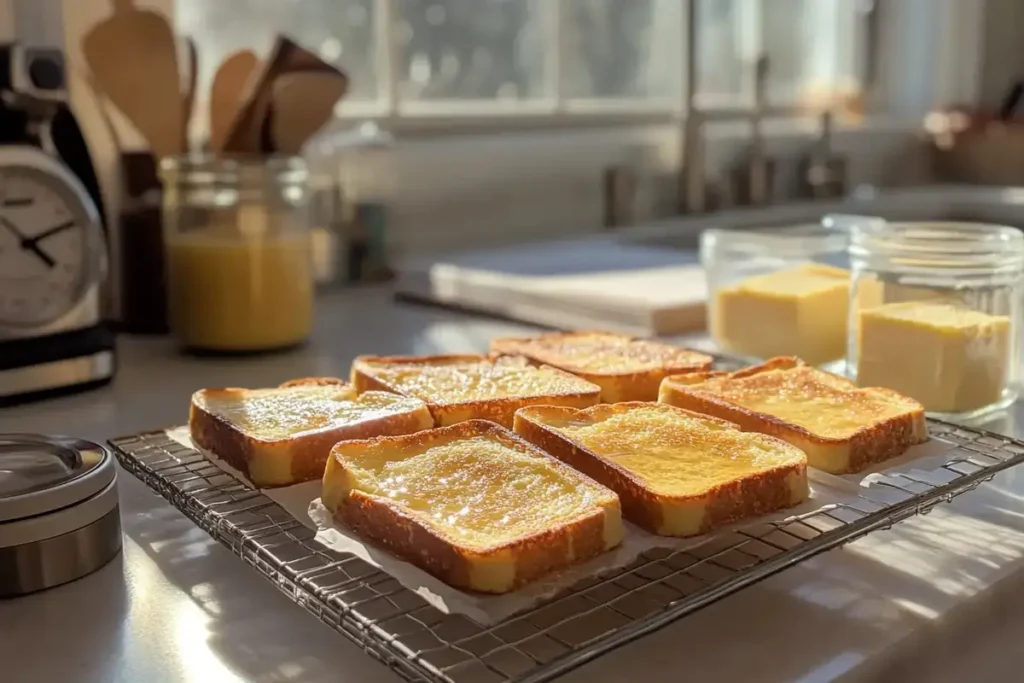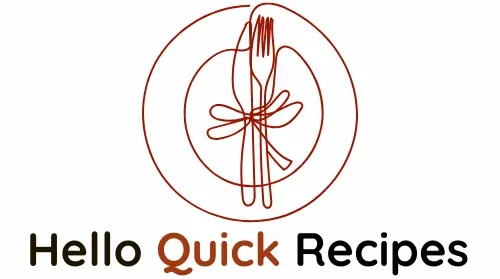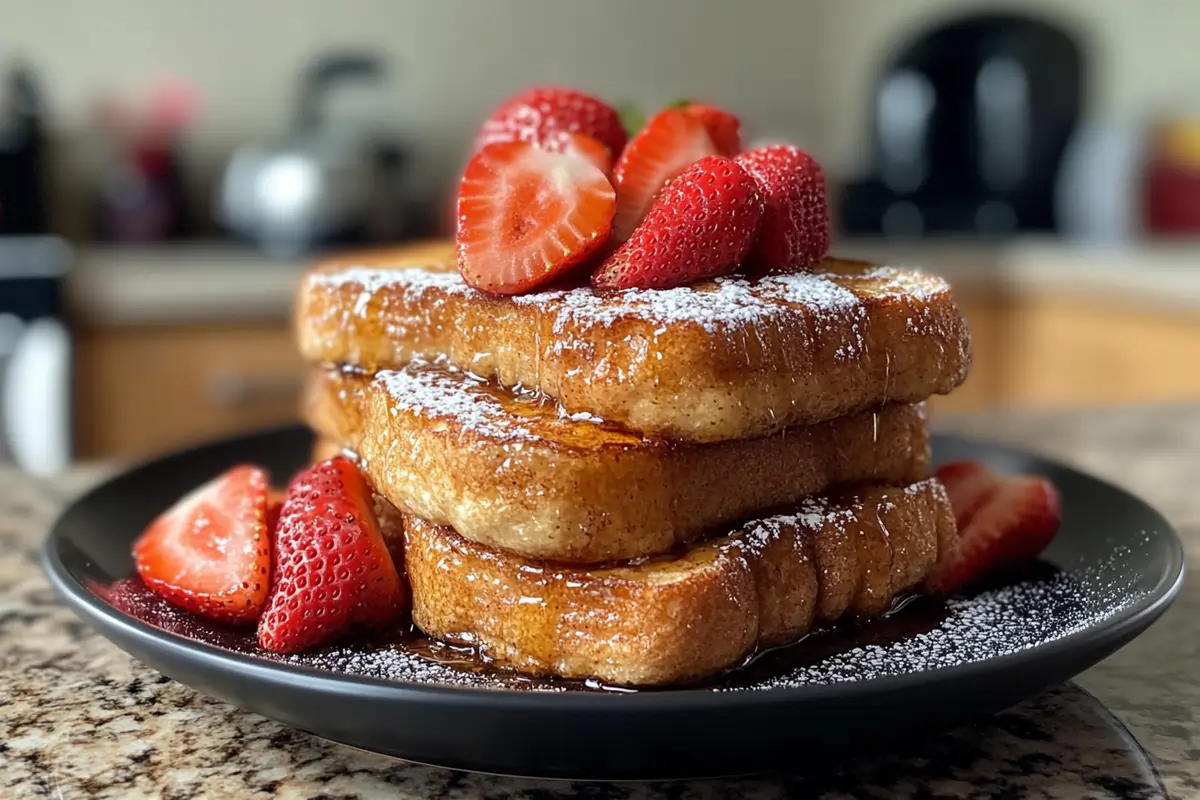French toast is a breakfast favorite that’s loved for its warm, sweet flavor and soft, golden texture. It’s made with simple ingredients like bread, eggs, and milk, but getting it just right can feel like magic. So, what is the trick to French toast? The answer is all about the small details—choosing the right bread, making a creamy batter, and cooking it just the right way. These easy tips can turn ordinary French toast into a meal everyone will love.
Table of Contents
1. Understanding the Basics of French Toast
1.1. The Origin of What is the Trick to French Toast
What is the trick to French toast? The answer lies in understanding its rich history and adaptability. French toast has been enjoyed for centuries, originating in ancient Rome, where cooks would soak stale bread in milk and eggs before frying it—a method documented in the Roman cookbook Apicius. Over time, cultures around the world have added their unique touches to this dish.
In France, it’s called pain perdu, meaning “lost bread,” as it traditionally uses day-old bread. In India, a savory twist incorporates spices like turmeric and chili, while in the United States, sweet toppings like syrup and fruit are popular. These global variations demonstrate that the trick to French toast is its ability to transform simple ingredients into something delicious, customizable, and universally loved.
1.2. Key Ingredients for Perfect French Toast: What is the Trick?
| Ingredient | Why It’s Important |
|---|---|
| Bread | The foundation of French toast. Stale bread absorbs the batter better without falling apart. Brioche or challah adds richness, while sourdough gives a tangy twist. |
| Eggs | The key to creating a custardy texture. Eggs bind the batter and help it cook evenly on the bread. |
| Milk | Adds moisture and creaminess. Whole milk or cream works best for a rich flavor. |
| Sugar and Flavorings | Ingredients like sugar, cinnamon, and vanilla enhance the flavor and aroma of the batter. |

1.3. Why Bread Selection Matters in What is the Trick to French Toast
Choosing the right bread is crucial for perfect French toast. Here’s why:
- Stale Bread Works Best: Slightly dried-out bread absorbs the batter without becoming soggy, leading to a better texture.
- Brioche or Challah: These soft, rich breads make a decadent French toast with a buttery flavor.
- Sourdough: This option adds a tangy flavor and holds up well during soaking and cooking.
- Thickness: Bread slices that are about ¾ to 1 inch thick work best, striking a balance between crispy edges and a soft, custardy center.
2. Mastering the Egg Mixture: What is the Trick to French Toast?
2.1. Choosing the Right Eggs and Dairy: The Trick Revealed
The foundation of great French toast lies in its egg mixture. Fresh eggs are essential, as they bind the ingredients together and create a creamy texture when cooked. For the dairy, rich options like whole milk, half-and-half, or heavy cream produce the best results. The fat content in these choices enhances the flavor and ensures a velvety consistency.
For those avoiding dairy, plant-based alternatives like almond milk, oat milk, or coconut milk can be used, though the flavor may vary slightly. The key is to maintain a balance: approximately one egg for every ¼ to ½ cup of liquid ensures the mixture is rich without being overly eggy.
2.2. Sweeteners and Spices: What is the Trick to Adding Flavor to French Toast?
The egg mixture is the perfect canvas for building flavor with sweeteners and spices. Here are some common additions:
- Sugar: A tablespoon or two of granulated or brown sugar adds sweetness and helps the French toast caramelize.
- Cinnamon: A sprinkle of ground cinnamon brings warmth and depth.
- Nutmeg: A pinch of freshly grated nutmeg elevates the flavor with a hint of spice.
- Vanilla Extract: A teaspoon of vanilla extract provides a subtle, sweet aroma.
These ingredients can be adjusted to taste, allowing for a classic flavor profile or a more adventurous twist.
2.3. Achieving the Ideal Consistency
The texture of the egg mixture is crucial for proper absorption and even cooking. Here are some tips:
- Whisk Thoroughly: Ensure that the eggs and dairy are fully combined for a smooth custard.
- Avoid Overloading the Mixture: Too much egg can make the toast taste overly savory, while too much liquid can make it soggy. Stick to the basic ratio of one egg per ¼ to ½ cup of liquid.
- Strain if Necessary: For an ultra-smooth consistency, you can strain the mixture through a fine sieve to remove any egg clumps.
- Let the Bread Soak: Allow each slice of bread to soak for about 20–30 seconds on each side to absorb the mixture evenly without falling apart.
By perfecting the egg mixture, you’ll set the stage for French toast that’s flavorful, fluffy, and perfectly textured.
3. What is the Trick to Cooking French Toast Perfectly?
3.1. Preheating and Oiling the Pan: A Crucial Trick
Getting the pan ready is a key step in what is the trick to French toast. Start by preheating the pan on medium heat. A pan that’s too cold will make the bread stick and cook unevenly, while a pan that’s too hot can burn the toast before the inside is done.
For greasing the pan, you can use butter, oil, or a mix of both. Butter adds a rich flavor but can burn quickly, so combining it with a neutral oil like vegetable or canola oil helps prevent this. Add just enough to coat the pan lightly. This ensures your French toast cooks evenly and gets that perfect golden-brown crust, which is an essential part of what is the trick to French toast.
3.2. The Perfect Flip: Timing and Tips
Flipping French toast at the right time is important for even cooking. After placing the soaked bread in the pan, let it cook undisturbed for about 2–3 minutes. You’ll know it’s ready to flip when the edges look set and the bottom is golden brown. Use a wide spatula to gently turn the toast over.
Cook the other side for another 2–3 minutes, checking to make sure it doesn’t overcook. If the bread is browning too quickly, lower the heat slightly to ensure the inside cooks properly without burning the outside.
3.3. Avoiding Mistakes: What is the Trick to French Toast Success?
Even with simple steps, a few mistakes can lead to less-than-perfect French toast. Here’s how to avoid them:
- Soggy Toast: Don’t oversoak the bread. A quick dip in the egg mixture (about 20–30 seconds per side) is enough to soak up the flavor without making the bread mushy.
- Burnt Edges: Keep the heat at medium. Exceeding the temperature will burn the exterior and prevent the interior from being cooked.
- Uneven Cooking: Spread the egg mixture evenly over the bread, and don’t overcrowd the pan. Cooking in batches ensures each slice gets enough heat.
- Dry Texture: Use thick slices of bread and a rich egg mixture. Thin slices or not enough batter can lead to dry French toast.
By following these tips, your French toast will come out perfectly golden, crispy on the outside, and soft on the inside every time!
4. Tips for Elevating Your French Toast Game
4.1. Creative Toppings and Garnishes
Toppings can take your French toast from simple to spectacular. Here are some ideas to try:
- Fresh Fruit: Add vibrant flavors with sliced strawberries, bananas, blueberries, or raspberries.
- Syrups: Classic maple syrup is always a favorite, but you can experiment with flavored syrups like caramel, chocolate, or fruit-infused options.
- Powdered Sugar: A light dusting of powdered sugar gives your French toast a beautiful, bakery-style finish.
- Whipped Cream: A dollop of whipped cream adds a creamy, sweet touch.
- Nuts and Seeds: Crushed nuts like almonds, pecans, or walnuts provide crunch, while chia or flaxseeds add a healthy twist.
- Spreads: Nutella, peanut butter, or cream cheese spread over warm French toast creates a rich and indulgent treat.
4.2. Making French Toast Ahead of Time: What is the Trick?
Want to enjoy French toast without the morning rush? Here’s how you can prepare it in advance:
- Cook and Freeze: Make a batch of French toast, let it cool, and freeze the slices in a single layer on a baking sheet. Transfer them to a freezer bag after being frozen.
- Reheat Properly: Reheat frozen French toast in a toaster, oven, or air fryer. For the oven, bake at 350°F (175°C) for 10–15 minutes, flipping halfway. This keeps the toast crispy outside and soft inside.
- Keep Warm for Guests: If serving right after cooking, keep the slices warm in an oven set to 200°F (95°C) while you prepare the rest.

4.3. Serving Ideas: What is the Trick to French Toast for Every Occasion?
French toast is versatile enough for any meal or event. Here are some serving ideas:
- Breakfast: Serve with a side of scrambled eggs and bacon for a hearty start to the day.
- Brunch: Pair with mimosas or coffee, and add a fresh salad or quiche for a sophisticated touch.
- Dessert: Transform your French toast into a sweet treat by topping it with ice cream, chocolate drizzle, and crushed cookies.
- Kid-Friendly: Cut French toast into sticks, serve with syrup for dipping, and pair with a glass of milk.
- Elegant Plating: Stack slices neatly, drizzle syrup over the top, and garnish with a sprig of mint or edible flowers for a picture-perfect presentation.
With these tips, you can turn French toast into a dish that’s as impressive as it is delicious, no matter the occasion.
5. FAQs About: What is the Trick to French Toast
How Do You Keep French Toast from Getting Soggy?
To prevent soggy French toast, use stale or slightly dry bread, which absorbs the custard without falling apart. Avoid oversoaking the bread; a quick dip on each side is enough. Cooking on medium heat ensures the toast is golden on the outside while fully cooked inside. For more ideas on enhancing French toast, check out sweet cinnamon sugar French toast muffins for inspiration.
Can You Make French Toast Without Milk?
Yes, French toast can be made without milk by using alternatives like almond milk, coconut milk, or even water. These options work well for those with dietary restrictions. Try adding a splash of vanilla or a pinch of cinnamon for extra flavor. Discover how to make a creative twist with croissant French toast for more ideas.
What’s the Best Way to Store Leftovers?
Store leftover French toast in an airtight container in the refrigerator for up to three days. Reheat in a toaster, oven, or skillet to restore its crisp texture.
How Do You Make French Toast Healthier?
For a healthier version, use whole-grain bread, replace cream with almond milk, and sweeten with honey or maple syrup instead of sugar. Adding fresh fruit on top is another nutritious option.
Can French Toast Be Made Vegan?
Yes, you can make vegan French toast by replacing eggs with ingredients like mashed bananas, flaxseed mixed with water, or tofu. Use plant-based milk, such as oat or almond milk, for the custard.
What’s the Difference Between French Toast and Bread Pudding?
French toast is cooked on a griddle or pan and made from individually soaked slices of bread. Bread pudding is baked in the oven, often as a casserole, with the bread pieces mixed in the custard. Both are delicious but have different textures and presentation styles.
6. Conclusion: The Secret to Perfect French Toast
Making the perfect French toast is easier than you think when you know the right tricks. Start by choosing the right bread—stale brioche, challah, or sourdough work best. Use a well-balanced egg mixture with fresh eggs, rich dairy, and just the right amount of sweeteners and spices. Take your time to preheat the pan, cook each side evenly, and avoid common mistakes like soggy or burnt toast.
Once you’ve mastered the basics, the fun begins! Add creative toppings like fresh fruit, flavored syrups, or a sprinkle of powdered sugar. Try healthier swaps or explore vegan options if you prefer. French toast is a versatile dish that can be served for breakfast, brunch, or even dessert.
The secret is confidence and creativity. With these tips, you’re ready to make French toast that’s golden, delicious, and completely your own. Enjoy!

